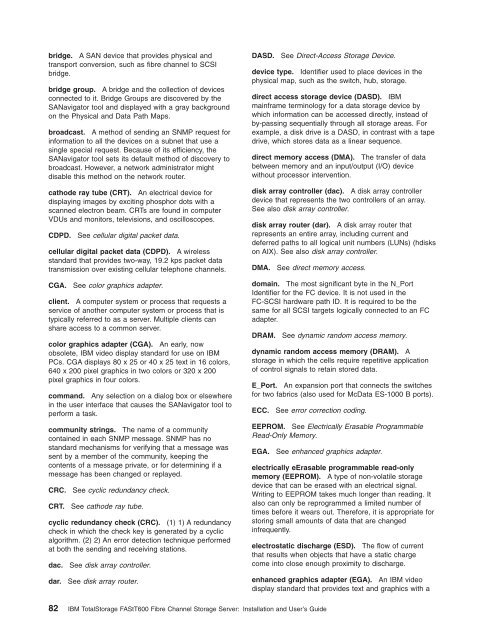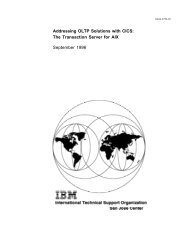install–38 - Ibm
install–38 - Ibm
install–38 - Ibm
Create successful ePaper yourself
Turn your PDF publications into a flip-book with our unique Google optimized e-Paper software.
idge. A SAN device that provides physical and<br />
transport conversion, such as fibre channel to SCSI<br />
bridge.<br />
bridge group. A bridge and the collection of devices<br />
connected to it. Bridge Groups are discovered by the<br />
SANavigator tool and displayed with a gray background<br />
on the Physical and Data Path Maps.<br />
broadcast. A method of sending an SNMP request for<br />
information to all the devices on a subnet that use a<br />
single special request. Because of its efficiency, the<br />
SANavigator tool sets its default method of discovery to<br />
broadcast. However, a network administrator might<br />
disable this method on the network router.<br />
cathode ray tube (CRT). An electrical device for<br />
displaying images by exciting phosphor dots with a<br />
scanned electron beam. CRTs are found in computer<br />
VDUs and monitors, televisions, and oscilloscopes.<br />
CDPD. See cellular digital packet data.<br />
cellular digital packet data (CDPD). A wireless<br />
standard that provides two-way, 19.2 kps packet data<br />
transmission over existing cellular telephone channels.<br />
CGA. See color graphics adapter.<br />
client. A computer system or process that requests a<br />
service of another computer system or process that is<br />
typically referred to as a server. Multiple clients can<br />
share access to a common server.<br />
color graphics adapter (CGA). An early, now<br />
obsolete, IBM video display standard for use on IBM<br />
PCs. CGA displays 80 x 25 or 40 x 25 text in 16 colors,<br />
640 x 200 pixel graphics in two colors or 320 x 200<br />
pixel graphics in four colors.<br />
command. Any selection on a dialog box or elsewhere<br />
in the user interface that causes the SANavigator tool to<br />
perform a task.<br />
community strings. The name of a community<br />
contained in each SNMP message. SNMP has no<br />
standard mechanisms for verifying that a message was<br />
sent by a member of the community, keeping the<br />
contents of a message private, or for determining if a<br />
message has been changed or replayed.<br />
CRC. See cyclic redundancy check.<br />
CRT. See cathode ray tube.<br />
cyclic redundancy check (CRC). (1) 1) A redundancy<br />
check in which the check key is generated by a cyclic<br />
algorithm. (2) 2) An error detection technique performed<br />
at both the sending and receiving stations.<br />
dac. See disk array controller.<br />
dar. See disk array router.<br />
DASD. See Direct-Access Storage Device.<br />
device type. Identifier used to place devices in the<br />
physical map, such as the switch, hub, storage.<br />
direct access storage device (DASD). IBM<br />
mainframe terminology for a data storage device by<br />
which information can be accessed directly, instead of<br />
by-passing sequentially through all storage areas. For<br />
example, a disk drive is a DASD, in contrast with a tape<br />
drive, which stores data as a linear sequence.<br />
direct memory access (DMA). The transfer of data<br />
between memory and an input/output (I/O) device<br />
without processor intervention.<br />
disk array controller (dac). A disk array controller<br />
device that represents the two controllers of an array.<br />
See also disk array controller.<br />
disk array router (dar). A disk array router that<br />
represents an entire array, including current and<br />
deferred paths to all logical unit numbers (LUNs) (hdisks<br />
on AIX). See also disk array controller.<br />
DMA. See direct memory access.<br />
domain. The most significant byte in the N_Port<br />
Identifier for the FC device. It is not used in the<br />
FC-SCSI hardware path ID. It is required to be the<br />
same for all SCSI targets logically connected to an FC<br />
adapter.<br />
DRAM. See dynamic random access memory.<br />
dynamic random access memory (DRAM). A<br />
storage in which the cells require repetitive application<br />
of control signals to retain stored data.<br />
E_Port. An expansion port that connects the switches<br />
for two fabrics (also used for McData ES-1000 B ports).<br />
ECC. See error correction coding.<br />
EEPROM. See Electrically Erasable Programmable<br />
Read-Only Memory.<br />
EGA. See enhanced graphics adapter.<br />
82 IBM TotalStorage FAStT600 Fibre Channel Storage Server: Installation and User’s Guide<br />
electrically eErasable programmable read-only<br />
memory (EEPROM). A type of non-volatile storage<br />
device that can be erased with an electrical signal.<br />
Writing to EEPROM takes much longer than reading. It<br />
also can only be reprogrammed a limited number of<br />
times before it wears out. Therefore, it is appropriate for<br />
storing small amounts of data that are changed<br />
infrequently.<br />
electrostatic discharge (ESD). The flow of current<br />
that results when objects that have a static charge<br />
come into close enough proximity to discharge.<br />
enhanced graphics adapter (EGA). An IBM video<br />
display standard that provides text and graphics with a
















